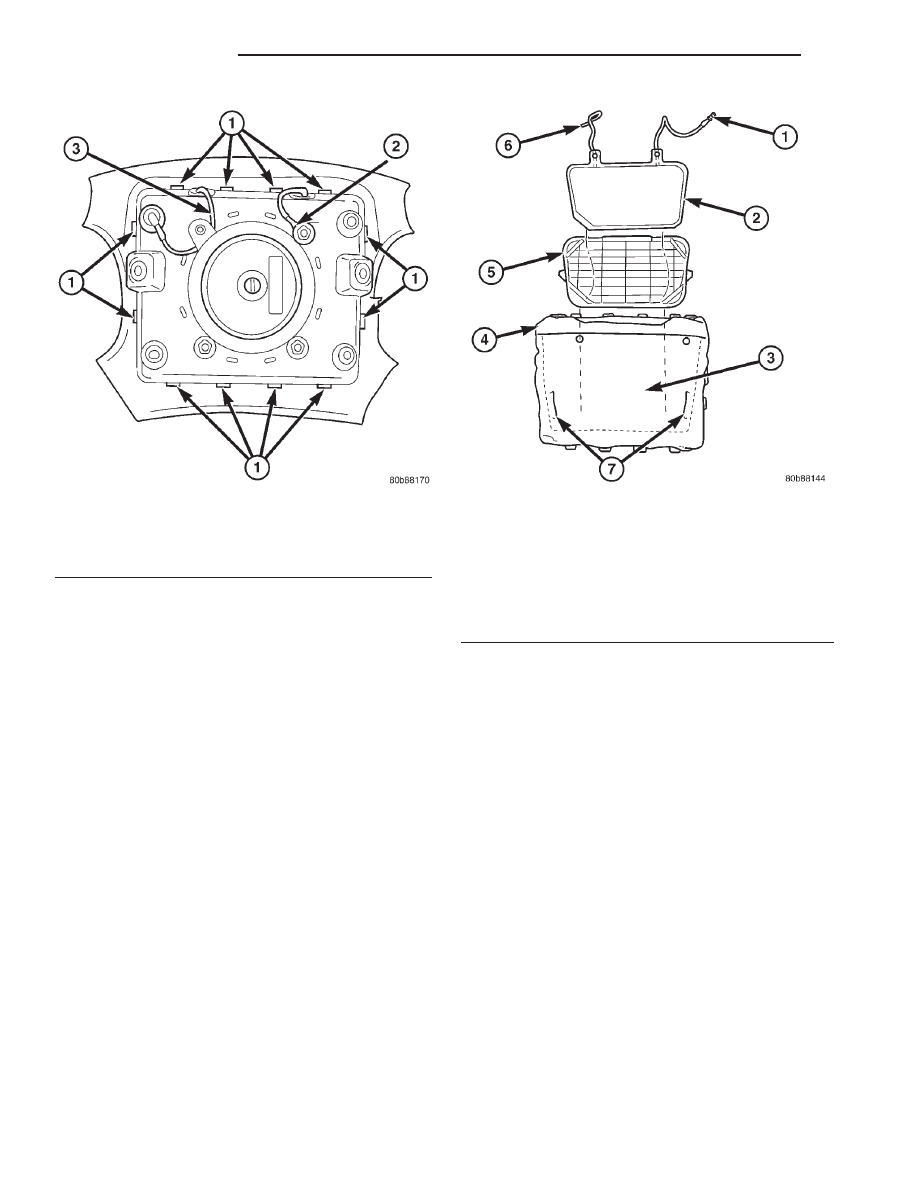Dodge Dakota (R1). Manual - part 349

complies with revised federal airbag standards to
deploy with less force than those used in some prior
models. The driver airbag is located in the center of
the steering wheel, where it is secured with two
screws to the steering wheel armature. Concealed
beneath the driver airbag trim cover are the horn
switch, the folded airbag cushion, the airbag retainer
or housing, the airbag inflator, and the retainers that
secure the inflator to the airbag housing. The resis-
tive membrane-type horn switch is secured within a
plastic tray that is inserted in a pocket or pouch
sewn onto the airbag cushion retainer strap, between
the trim cover and the folded airbag cushion (Fig.
11). The airbag inflator is a conventional non-azide,
pyrotechnic-type unit with four studs and it is
secured to the stamped metal airbag housing with
four nuts.
The trim cover has an airbag receptacle molded
into the back side of it. The four vertical walls of this
receptacle have a total of twelve small windows with
blocking tabs that are engaged by twelve hook forma-
tions around the perimeter of the airbag housing.
Each hook is inserted through one of the windows,
the integral blocking tab in each window keeps each
hook properly engaged with the trim cover, locking
the cover securely into place. One horn switch pigtail
wire has an eyelet terminal connector that is cap-
tured beneath a nut and washer on the upper right
inflator mounting stud. The other horn switch pigtail
wire is routed between the upper left inflator mount-
ing stud and the inflator, where it is captured by a
small plastic retainer that is pushed onto the stud.
The driver airbag cannot be repaired, and must be
replaced if deployed or in any way damaged. The
driver airbag trim cover and the horn switch with
tray are available, and may be disassembled from the
driver airbag for service replacement.
OPERATION
The driver airbag is deployed by an electrical sig-
nal generated by the Airbag Control Module (ACM)
through the driver airbag line 1 and line 2 (or squib)
circuits. When the ACM sends the proper electrical
signal to the airbag inflator, the electrical energy
generates enough heat to initiate a small pyrotechnic
charge which, in turn, ignites chemical pellets within
the inflator. Once ignited, these chemical pellets burn
rapidly and produce a large quantity of nitrogen gas.
The inflator is sealed to the back of the airbag hous-
ing and a diffuser in the inflator directs all of the
nitrogen gas into the airbag cushion, causing the
cushion to inflate. As the cushion inflates, the driver
airbag trim cover will split at predetermined break-
out lines, then fold back out of the way along with
Fig. 10 Driver Airbag
1 - HOUSING HOOKS (12)
2 - HORN SWITCH GROUND PIGTAIL WIRE
3 - HORN SWITCH FEED PIGTAIL WIRE
Fig. 11 Horn Switch
1 - HORN SWITCH GROUND PIGTAIL WIRE
2 - HORN SWITCH
3 - POUCH
4 - DRIVER AIRBAG (TRIM COVER REMOVED)
5 - TRAY
6 - HORN SWITCH FEED PIGTAIL WIRE
7 - POUCH SLITS
8O - 14
RESTRAINTS
AN
DRIVER AIRBAG (Continued)